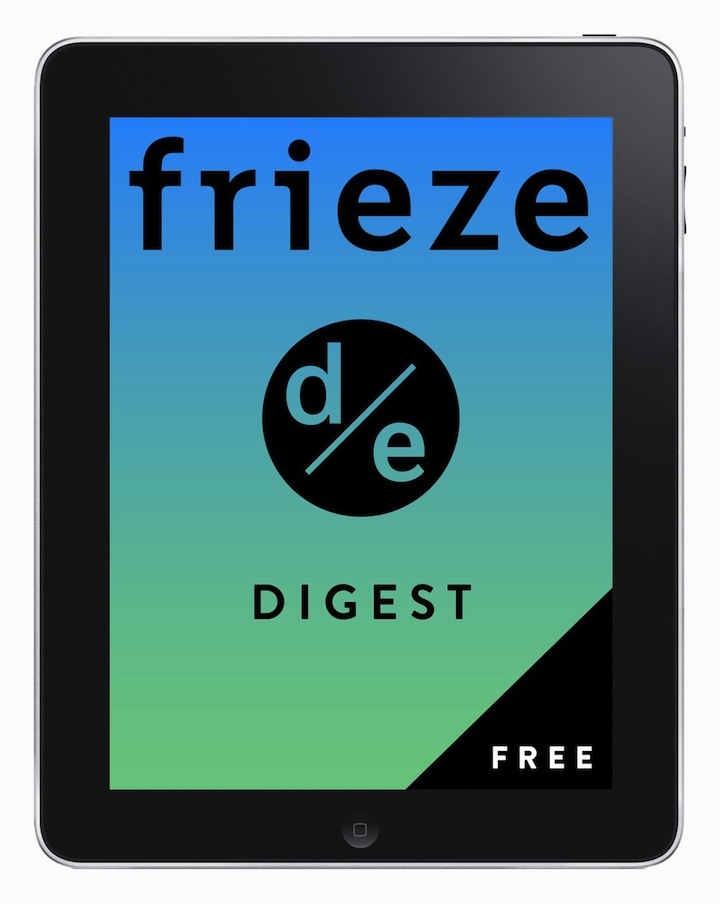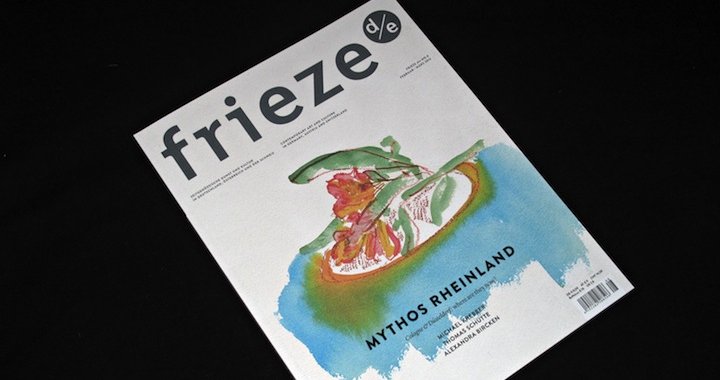
Remedies with Side-effects
Alida Ivanov
30/04/2013
Berlin-based Jörg Heiser is the co-editor of frieze and the co-publisher of frieze d/e. His biography on friezefoundation.org is one sentence, much like the one I just wrote.
To start from the beginning: in the 1990s Jörg Heiser studied philosophy in Frankfurt and received his MA in 1995. During that time he co-founded a cultural magazine, a quarterly called Heaven Sent, a name taken from a song by the Scottish band Josef K. Among some of the contributors were philosopher Slavoj Zizek and writer Diedrich Diederichsen. As a freelance music critic, he predominantly wrote about pop music, but started writing about art in 1993. In 1997 Heiser got to know one of the editors of frieze at the time, James Roberts in Berlin, and was asked to write reviews from the city. In 1998 Heiser became their Berlin-based associate editor. In 2003 he then became co-editor with Jennifer Higgie. In April 2011 frieze d/e was launched as a bilingual sister to frieze.
Jörg Heiser also curates once in a while and has made exhibitions like Funky Lessons at the Büro Friedrich in Berlin and BAWAG Foundation in Vienna (2004/05), and more recently, the show Romantic Conceptualism at Kunsthalle Nürnberg and the BAWAG Foundation (2007).
I still, however, felt that I wanted to know more as I really find the combination that he represents interesting – discussing issues of art critique, curating and the different roles in the art world.
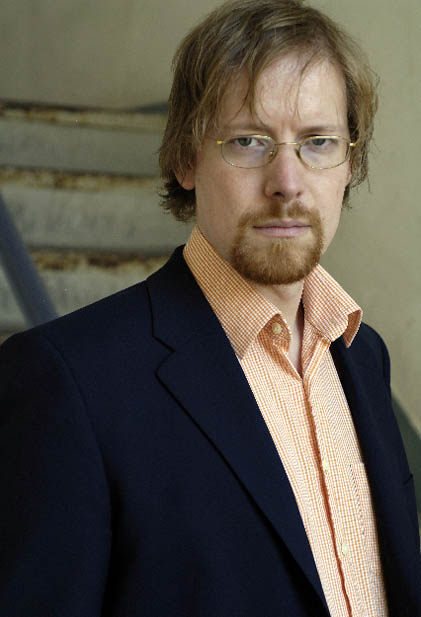
Jörg Heiser
Why do you think that frieze is so popular… or is it?
(Laughs) I guess it is quite popular. We have more than 86 000 followers on Twitter, if that counts for any kind popularity.
That’s a good number. I guess it’s a very contemporary way of counting popularity…
At the same time, we’re still a special interest magazine. Popularity, in quantifiable terms, is not necessarily what defines the reputation of an art magazine. The actual point, for me, is that we get the impression of the actual pieces that we publish; that we trigger debates, or advance the reading of an artist’s work. For example, another way of accounting popularity is when you google an artist’s name. Most likely, what would come up is an article from the frieze archive: there is more than 20 years of the magazine online.
I really like the iPad-version of frieze. It’s very interactive and engages you in a different way than a printed magazine would. What is the future for the printed magazine, is it becoming more and more obsolete?
For the time being, the printed magazine is not obsolete. First of all, people do actually read printed magazines, but they may not use an iPad, as it’s such a constricted Apple environment.
The print magazine has a particular design: even including particularities, like spot varnished covers, different kinds of paper stocks, etc. It’s a haptic experience and not only a reading, or visual experience. Even though there are certain advantages to an iPad-version. It allows you to include more images, moving images. For example, the frieze app has frieze films in it. Then again, there are people out there, myself included, who still just don’t want to miss holding the printed magazine in their hands, flipping through it. So, I think it will stay for quite some time.
The watershed has not yet been reached where the print magazine has become obsolete. But it may happen in the future, especially if we get beyond the all-too controlled corporate digital environments, like with the iPad.
So, could you explain a bit more the necessity of launching frieze d/e?
It’s a separate, independent and bilingual sister publication to frieze, with focus on Germany, Austria and Switzerland. The reason why we did it was that we started to realize that we’ve had an office in Berlin since the late 1990s and that we have a certain on-the-ground expertise of the art world in that region; an area that warranted a separate magazine. Namely because, for one: the art world has grown exponentially. In that region it has grown to the extent that it has become almost impossible to cover everything that warrants to be covered in the international edition of frieze. And secondly, because we felt that nobody was really doing the kind of job that frieze does internationally, in the way that frieze does it, in that area. It offers a platform for a much more internationalized discourse in cities like Berlin, Vienna or Zurich. This kind of internationalized environment basically didn’t exist 10 or 15 years ago, at least not to that extent, and we wanted to reflect this development by establishing frieze d/e.
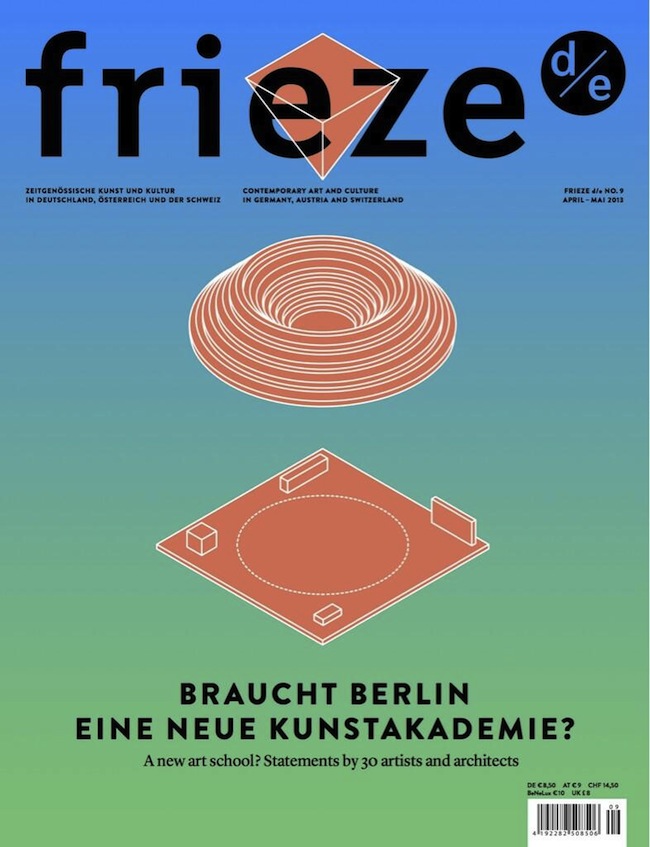
frieze d/e. Cover of April - May 2013 issue
Do you think that more magazines will specialize themselves to different regions?
Of course, there are existing magazines in Germany, Holland and France that have a regional focus. For us it was more about the combination of an international magazine and d/e being a kind of complement to it. Rather than covering ‘the entire art world’, whatever that means, we give it a regional focus. By doing that, we are covering a lot of international stuff, especially in Berlin. But also in other places in the region – there is a lot of international activity going on.
Berlin, as you know, has seen an amazing increase of artists from all over the world moving there, and galleries with international backgrounds opening up there. At the same time, there is a strong traditional and institutional landscape, arguably the largest in the world. If you think of kunstvereins and museums for contemporary art, there are almost a hundred of them that have internationally reputed programs in Germany. Also for Switzerland, and to some extent Austria too – that alone is an important factor that should be reflected in a magazine like frieze d/e.
What is the current state of art criticism today? Is art criticism dead…?
That is an age-old question…
Did it die, and then get resurrected? What happened?
Art criticism: the very word is related to crisis, etymologically. If you define “crisis” as a point where you have to decide things, to make a judgment. That is what the original word means: a crisis is a state that needs decision-making. Originally, the term, in Greek I guess, was referring to doctors having to decide how a patient should be treated. Not that art is a patient. Criticism’s role of providing analysis, perspective and aesthetic judgment is still viable, and maybe even more so than before.
With the global expansion of the art world, obviously there are difficulties navigating in this exponentially increased amount of work being done, amount of exhibitions put on around the world. You need people whose job it is to navigate this environment and who try to make sense of it, and also bring crucial questions to it. Magazines like frieze and others are trying to do that. Despite the usual ongoing dissatisfaction with some types of criticism, they are still doing their job.
But how can you critique something that you’re a part of? Don’t you become snow-blind, so to speak…
The opposite would be a problem. If you fantasize yourself as being outside of something, you start to loose touch with it. We’re not forensic scientists looking at the dead body of art. We’re people that are engaged with it. Of course, we need to reflect on our conflicts of interest and on our maybe-biased perspectives. As long as you are up front about these biases, and reflecting on your own involvements, I think that that is a pretty good perspective to make judgments from, because you know what you’re talking about.
You mentioned before, with the meaning of criticism, that art is not a patient. If one would look at the word “curator” as coming from “curare”, as in cure: are curators the cure, then?
Remedies can be a part of the problem, and can produce side-effects. It’s the job of the curator, and of the critic as well, to keep these side-effects in check. To beware of the pitfalls of judging art, selecting art, and all these kind of things.
What we’re dealing with are the general productions of artists that deserve to be taken serious and deserve getting the space they need, rather than being shoehorned into preconceived or prescriptive concepts. So, as long as the curator keeps the necessary respect for artistic production while keeping crucial broader questions of society in mind, I think they have an important and beneficial role. But there is a certain danger with curators seeing themselves as sort of meta-artists, which often leads to misconceptions of the curator’s role.
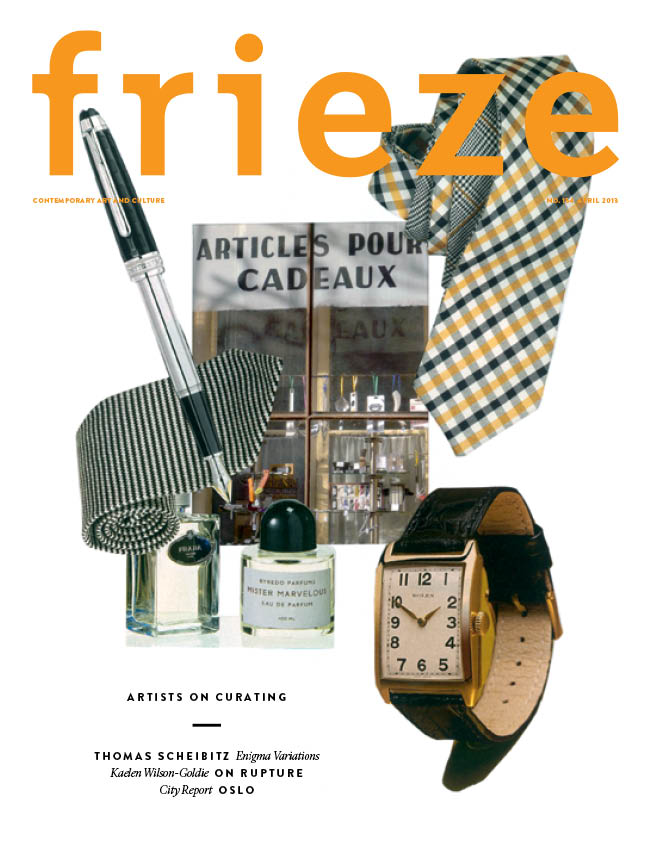
frieze. Cover of April 2013 issue
I feel that misconceptions of the curator’s role are quite common; could you explain that role a bit further?
Well, I mean, already that it deserves a different name from artist points to the fact that it’s not the same, and that the role of the curator is to come up, or think hard about ways of communicating art, and doing so both in terms of circulating information and, of course, in spatial terms: questions of display. The curator’s role historically, but even still today, is a sort of hybrid one. It combines aspects of the critic, of the gallerist, of the architect or interior designer, and maybe also the artist. Also, it’s combined indeed with curare, in the sense of preservation of artworks, which allows them to live on practically, making sure they are stored and transported correctly, etc. But also in a more virtual sense: making sure that artworks get the recognition they deserve and are not being forgotten.
What are your main interests as a curator, and do they differ from you as writer?
First of all, I see myself as predominantly a critic. I only curate once in awhile, on an irregular basis. Also, I purposely tend to only curate if an idea occurs that I feel warrants that, and it usually comes out of my writing. Funky Lessons in 2003: I was initially asked to do a symposium about conceptual art and the question of didacticism, and then out of that came a discussion in which Waling Boers of Buero Friedrich, Berlin (now he runs Boers-Li Gallery in Beijing), and I eventually decided instead of doing a symposium, to do a show and a catalogue. Somewhat similarly with Romantic Conceptualism in 2007: I wrote a piece in frieze and someone approached me whether I could see myself turning that into an exhibition. To cut a long story short: it ended up being an exhibition at the Kunsthalle Nürnberg, and then at the BAWAG Foundation in Vienna. That’s pretty much how it has played out so far. My latest project, at Fondazione Morra Greco in Naples, is a series of solo projects entitled ‘Hybrid Naples’, also came out of my interest into current, ‘super-hybrid’ artistic production.
Like I said earlier, for me, curating is something that comes out of my writing. I find it very fruitful and it gives me insight into how artists work. It also gives me an opportunity to enter a direct discussion with artists about how to make new work, how to present exciting work in a proper way. That is a perspective that I usually don’t have as a critic. It offers me a different insight than I would get otherwise, but in terms of avoiding increased conflicts of interest, I purposely don’t do it often. Once you start curating on a regular basis it is hard as a critic, and even more so as an editor of a magazine, to keep these things apart. I don’t want to end up creating the impression that whatever I’m covering in frieze is only done so in connection to whatever I curate.
You mentioned before you started your talk on Sterling Ruby at Bonniers Konsthall in February, that all of the art critics in Sweden are curators now.
Actually, Sara Arrhenius was quoting me there, with a statement from ten years earlier....
Can you be both?
Again, I wouldn’t be too prescriptive about that. I think it depends on how you bring out your talents, so to speak. Sometimes someone is good precisely in combining those two things. Sometimes it could run the danger of reducing the criticism or the writing to a kind of supportive, or even promotional action, in relation to the curating.
It also depends on the kind of writing you do. You can easily imagine a full-time curator that writes in-depth, lets say, catalogue pieces exploring someone’s work, or they write more philosophical or sociological writings. But for me, the sort of core job of the critic is to write the classical review, or monographic critical piece about an artist’s work, in a magazine or a newspaper or online. And to do that job properly, I don’t know about Sweden, at least in Germany in the newspapers and the magazines it is usually not the directors of kunstvereins or museums that write reviews, and I think that is fair enough. Not only because they have enough work on their plate already, but because they inevitably have a compromised position. Like, imagine you’re a curator at a kunsthalle somewhere, and then you write a negative review of a show at an institution in the same city – that would certainly come across as being biased because of some competition going on, or whatever.
For a magazine, it’s vital that we know that whoever is writing a review or a critical piece has a position that is not compromised by direct competition with whomever they write about. That’s the main point. That means, in some ways, that curators have to be careful what they write about, and that goes for the critics, too. There are very few critics that are not involved, at least occasionally, in curating something. As long as they keep that in mind, and are careful about not creating these kinds of situations in which whatever they write is meant as a competitive, self-serving intervention.
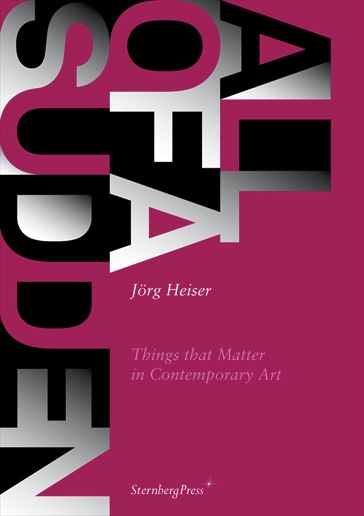
Jörg Heiser. “All of a Sudden. Things that Matter in Contemporary Art”
Do you feel that people are too careful in art criticism nowadays?
Sometimes they are. That is a broader issue that doesn’t necessarily have to do with their professional roles, in terms of being a critic versus a curator, and so on. Even if they’re full-time critics, or whether they’re full-time artists, or curators, and nothing else; they all live in a social environment that has a certain quality that you can compare to the way Facebook is set up. The emphasis is on networking, on affirmation and a mutual sort of shoulder-patting, rather than on confrontation.
Often, the confrontation takes place in the form of gossip or snark, anonymous snark, rather than as an open confrontational debate. And for me, it’s crucial that criticism in magazines, or newspapers, or online outlets, allows for confrontational, or pronouncedly critical responses, even at the risk of creating negative feedback or creating fallout with people. I think that is crucial. I do see certain tendencies of people trying to avoid that, especially if they see their critical writing as a step towards something else: becoming a successful curator or something, or seeing it as a step towards getting well-paid catalogue-writing commissions.
A good critic, in the moment of writing, will be happy to kill their darlings, so to speak, when the piece of writing needs it. Once they make their point, they have to be willing to also run the risk of upsetting people, even if these people might be their future contractors. I think that is the underlying issue. People are scared of criticizing people who, half a year later, might give them a job. And that’s the Facebook networking culture.
I wouldn’t even blame them entirely for this hesitance to be openly critical. It is a symptom of a social environment that has become more and more defined by precarious short-term working relationships, rather than long-term and secure ones. In precarious short-term working relationships, you want to keep your network as wide as possible, to be connected to the next project you might get a job on, so that is not necessarily beneficial to critical writing. But as I said before, as a good critic, you have to, in the process of writing, be able to develop a productive temporary amnesia about that, about thoughts like “oh this might harm me if I write that now”. In the actual piece of writing, if the argument needs it, they have to be able to do it, nevertheless. I think that is a quality you see, to use a comparison, in great novelists. Many of the great novels have a subtext in which they are inevitably pissing someone off by portraying them in a way that isn’t very beneficial to them. Often, great novelists have done so regardless, because the story needed it, or they felt they had to get that out. I think critics can take an example from that.
What critics do you like right now?
Well, there’s many. Which critic do I like the most...? I’ll just name two. One, obviously being biased, with me working at frieze, but I’ve been excited about some of the things that my colleague and co-editor, Dan Fox from New York, has been doing. For example, he wrote a really great State of the Art in frieze recently. It’s this kind of editorial column in the beginning of the magazine, which was called “Dear Claes”. It took as a cue this famous manifesto by Claes Oldenburg from the early 60’s. He used it to talk about the contemporary art environment, and asking for certain things to be kept in mind. I think that was a very nicely put and a very smart way of pinpointing some of the problems we have in these environments.
Another piece that comes to mind is a recent book by Jean Francois Chevrier, French critic and theorist – he wrote a book about the idea of the hallucinating artist, from William Blake to Sigmar Polke. I found that really inspiring, and it gave me a new perspective on the art of the last 250 years, or so.
Have you seen any good shows lately?
Hmm, let me think. There is a huge show of Martin Kippenberger at Hamburger Bahnhof. There are some things that you can criticize about that show, but all in all, it gives a great opportunity to see amazing work by Kippenberger.
What are your plans for the future?
What are my plans for the future??
Yes, in a 10-year period. (Laughs)
Well, I love my job with frieze, and I want to continue. We’ve done nine issues of frieze d/e so far. So we’re still kind of nurturing a baby there, so to speak. I see it as one of my major tasks: to make sure that this baby grows into a great, long-term magazine. So that’s my plan for the future, in that regard. Otherwise, there are book projects in the pipeline that, over the next couple of years, hopefully, I will find some time to realize.
